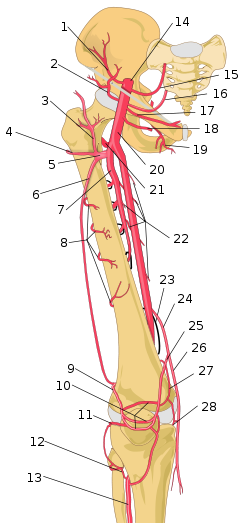Superficial femoral artery
| Femoral artery | |
|---|---|

Structures passing behind the inguinal ligament. (Femoral artery labeled at upper right.)
|
|

Schema of femoral artery (labeled as #20) and its major branches - right thigh, anterior view.
|
|
| Details | |
| Source | External iliac artery |
| Branches | Superficial epigastric artery, superficial iliac circumflex, superficial external pudendal, deep external pudendal, deep femoral artery, continues as popliteal artery |
| Vein | Femoral vein |
| Supplies | Anterior compartment of thigh |
| Identifiers | |
| Latin | Arteria femoralis |
| MeSH | A07.231.114.351 |
| Dorlands /Elsevier |
a_61/12154275 |
| TA | A12.2.16.010 |
| FMA | 70248 |
|
Anatomical terminology []
|
|
The femoral artery (Latin: arteria femoralis) is the second largest artery in the body (second to the aorta) and is in the thigh and the main arterial supply to the lower limb. It enters the thigh from behind the inguinal ligament as the common femoral artery, a continuation of the external iliac artery. Here, it lies midway between the anterior superior iliac spine and the symphysis pubis. The common femoral artery gives off the profunda femoris artery and becomes the superficial femoral artery to descend along the anteromedial part of the thigh in the femoral triangle. It enters and passes through the adductor (subsartorial) canal, and becomes the popliteal artery as it passes through an opening in adductor magnus near the junction of the middle and distal thirds of the thigh.
Its first three or four centimetres are enclosed, with the femoral vein, in the femoral sheath. The relations of the femoral artery are as follows:
The femoral artery gives off several branches in the thigh which include;
In clinical parlance, the part of the femoral artery proximal to the origin of profunda femoris is often termed the common femoral artery, while that distal to the origin of the profunda is termed the superficial femoral artery.
As the femoral artery can often be palpated through the skin, it is often used as a catheter access artery. From it, wires and catheters can be directed anywhere in the arterial system for intervention or diagnostics, including the heart, brain, kidneys, arms and legs. The direction of the needle in the femoral artery can be against blood flow (retro-grade), for intervention and diagnostic towards the heart and opposite leg, or with the flow (ante-grade or ipsi-lateral) for diagnostics and intervention on the same leg. Access in either the left or right femoral artery is possible and depends on the type of intervention or diagnostic.
...
Wikipedia
